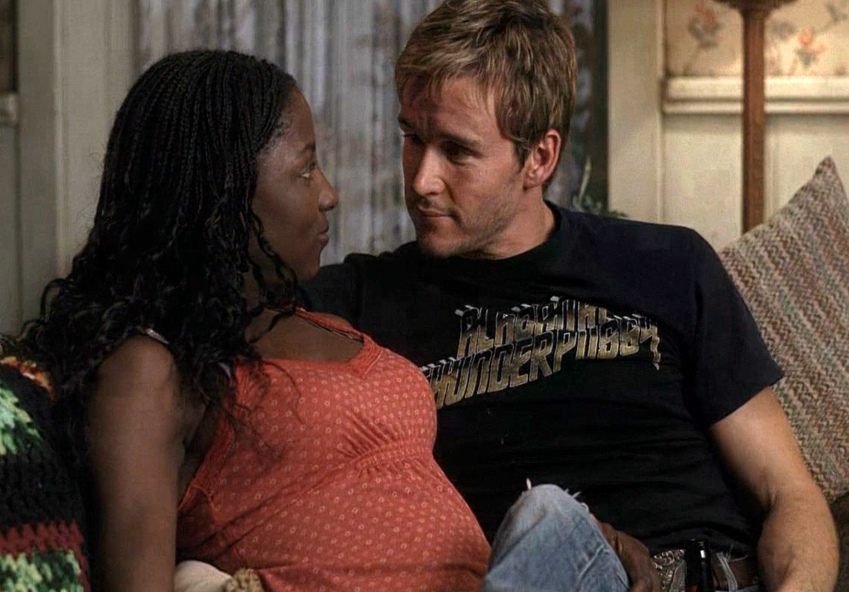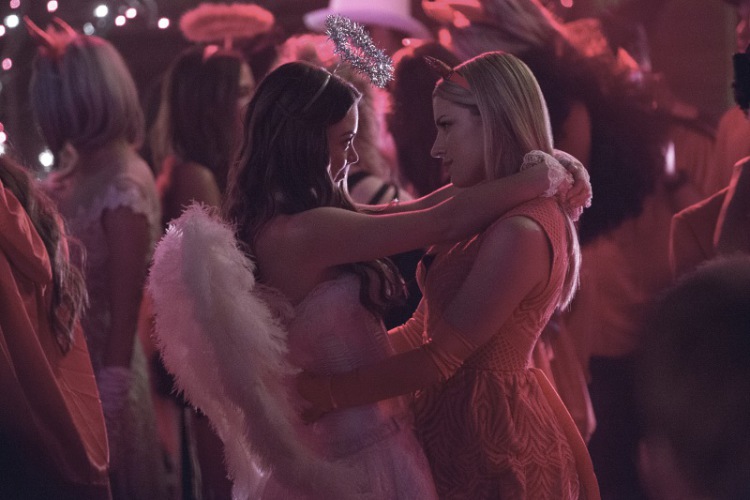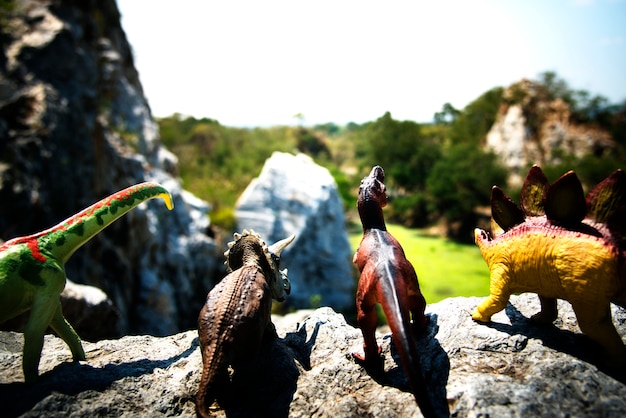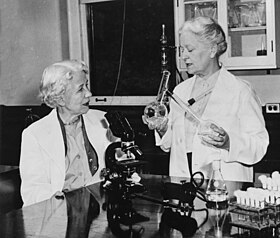More Fluid Than Blood
Vampires and Bisexuality
- H. Bradford
12/10/17
Each month, Pandemonium meets to discuss issues related to bi+ identities and organizing. This month, the group gathered to discuss vampires and bisexuality. Anyone who has watched or read vampire themed media might have observed that vampires are often portrayed with ambiguous sexualities, if not outright gay, lesbian, or bisexual. The following presentation seeks to uncover the history of how vampire sexuality has been depicted as well as the implications of these representations. Vampires are very much a reflection of the times in which they were imagined. As monsters, they represent challenges to the social order. Since bisexuality, or for that matter any non-heterosexual sexuality, is a challenge to heteronormative patriarchy, it makes sense that vampires often lend themselves to a queer reading.
Before they were the subject of books or television series, vampires have long been imagined beings from the folklore of many cultures. Blood drinking spirits appear in the stories of many cultures, but vampires as they are understood today were mostly based upon the tales of Eastern Europe. These stories entered the public consciousness of Western Europeans during the 18th century with several highly publicized cases of vampirism within East Prussia and the Hapsburg Empire. Incidents of vampirism and the related hysteria was investigated by 18th century scholars and Maria Teresa of Austria sent her physician to uncover the truth about vampires. He concluded that they were not real and she subsequently passed laws against opening graves or desecrating the dead, which put an end to outbreaks of vampire panics. From then on, vampires, at least in Western Europe, were mostly a matter of fiction. Thus, vampires began appearing in Western European fiction in the early 1800s. The spread of vampires in Western Europe from Eastern Europe represents a transition of folklore and superstition from the lesser developed parts of Europe to the large, urbanized, mostly literate population of the West (Paolucci, 2000).

A “vampire” skull from 1500s Venice, found among plague victims
One of the first works of vampire fiction was Polidori’s 1918 story The Vampyre, which featured a vampire named Lord Ruthven. Polidori served as Lord Byron’s physician and his character, Lord Ruthven, established the trope of that vampires should be aristocratic and seductive (Primuth, 2014). The plot of the book involves Lord Ruthven travelling around Europe as he seduces various women, often accompanied by his friend Aubrey. Ruthven and Aubrey have a falling out, but reconcile. Later, Aubrey watches Lord Ruthven die and makes a promise not to tell anyone of his death. Aubrey stays true to the promise, even after Ruthven is later discovered to be alive. Only when Ruthven tries to marry Aubrey’s sister, does he confess his oath in a letter. Ruthven kills Aubrey’s sister on their wedding night and Aubrey dies as well. While the story is interesting because it establishes the notion that vampires are alluring, sexual, and aristocratic, it is also of interest because Lord Ruthven may have been based on Lord Byron.
Early Vampire Literature
Prior to the publishing of The Vampyre, Byron wrote a poem about a vampire in 1810 while touring Greece. The poem entitled The Giaour takes place in Greece, then ruled by the Ottomans, wherein a character named Leila is killed for her infidelity to her husband, Hassan. Her lover avenges her death by killing Hassan, but Hassan curses him to become a vampire. This early take on the vampire does not have common conventions such as fangs, sleeping in coffins, aversion to sunlight, etc. Yet, the vampire character in the poem is a Byronic hero inasmuch as he is cursed, dangerous, and an outsider (as Giaour means infidel) (Luchsinger, 2015). Later, in 1816, Lord Byron stayed in Lake Geneva with his physician, Poliodori, as well as Mary Shelley and Percy Blythe Shelley and his mistress, Jane Clairmont. During their stay, there was a snow storm, during which they challenged each other to invent stories for entertainment. Mary Shelley developed the story of Frankenstein. Byron began a story about a vampire, which Polidori fleshed out and published as The Vampyre (Lord Byron’s image inspired modern take on vampires, 2010).
Lord Byron, or George Gordon, was a controversial, larger than life figure in his day. He may have had a child with his half-sister Augusta. It is also speculated that he may have been more than friends with Mary Shelley and Percy Blythe Shelley. There is evidence that he was not strictly heterosexual. He wrote poetry under the female name Thyzra to John Edelston, a young choir member who he fell in love with at the age of 17. In letters that he wrote during his travels in Greece and Turkey in 1810, he expressed his interest in seeking same sex encounters in these places, which were more tolerant at the time. He also bragged to friends back home that he had 200 sexual encounters while in Greece and Turkey. At the same time, the punishment for sodomy in England in the early 1800s was death. In 1815, he married Annabelle Milbanke, who left him a year later with their infant daughter. She went to stay with her parents and requested a separation, which unleashed various rumors about his relationship with his sister, adultery, and sodomy. He negotiated a separation from his wife outside of the courts and left for Europe, where The Vampyre was written (MacCarthy, 2002). Certainly, the plot line of the story mirrors his life, as the vampire travels through Europe seducing and harming women in locales such as Italy and Greece, then eventually England. The plot line of Aubrey following Lord Ruthven around Europe, then having a falling out, also mirrors the falling out that Polidori had with Lord Byron. Finally, while Ruthven mostly preys upon women, the relationship between Ruthven and Aubrey may hint at bisexuality. Paolucci (2000) suggests that a cave scene between Ruthven and Aubrey is suggestively sexual and that Aubrey’s refusal to believe in the supernatural is a rhetorical denial of queerness.
It is difficult to classify Lord Byron’s sexuality, since modern sexual identities were not yet developed. The word bisexual was not used until 1892 in the Psychopathia Sexualis, a book about sexual pathologies. While Byron might be viewed as bisexual, inasmuch as he expressed attraction to both men and women, caution should be used in applying modern notions of sexuality to people and situations that pre-date these understandings. Still, he was one of the first famous writers to be labeled bisexual. Though, literary scholar Emily Bernard Jackson warned against this, arguing instead that his sexuality was too fluid and complex for labels (Lord Byron, n.d.). Nevertheless, in studying the history of bisexuality and vampire’s in the media, it is certainly important to recognize that the first vampire in English literature was modelled after Byron, who was controversial, charismatic, and attracted to both men and women. In this sense, bisexuality, is built into the fabric of vampire literature, even if Ruthven’s character is not overtly bisexual. At the same time, this inclusion isn’t necessarily positive, as homosexual/bisexual behaviors and attractions were viewed as deviant.

Lord Byron- the inspiration of Lord Ruthven- an early vampire in Western fiction
In the 1840s, Varney the Vampire appeared as a newspaper serial (Primuth, 2014). Varney the Vampire introduced some modern staples of vampire stories, such as fangs, nocturnal visits, entry through a window, super strength, and hypnotic power. He is also a sympathetic vampire, even though part of the plot of the series involves him trying to take advantage of Bannersworth family. Varney is important because he was the first sympathetic vampire. He feels guilty and alone, and tries to control his predatory nature. He mourns his wife and children from 180 years earlier and is the first vampire to commit suicide. He is attracted to young, virginal women and seems primarily interested in women (Paolucci, 2000). Varney is not a virtuous vampire, but he is a conflicted vampire that is not always villainous. It is possible that his perceived heterosexuality is used to cast him as a “good” vampire rather than a deviant, villainous vampire. There is less scholarly work on the sexuality of Varney, as opposed to other vampires of the 1800s.
Carmilla and Lesbian Vampires
While Varney the Vampire has not lent itself to extensive and rigorous analysis for sexual themes, the novella Carmilla has. Published in 1871, the novella Carmilla predates Dracula by 26 years. Joseph Sheridan Fanu’s novella follows the story of a girl named Laura, who befriends a mysterious girl named Carmilla. Carmilla makes romantic advances on Laura, does not join her family in prayer, sleepwalks at night, and sleeps during the day. Girls in the nearby village begin to become sick and die, while Laura herself begins to have strange dreams, poor health, and mysterious bites on her chest. Eventually, it is discovered that Carmilla is actually Countess Mircalla, a noblewoman from two hundred years prior who had a relationship with a woman whose decedent became a vampire hunter. Laura, whose memory of the events is unsteady, does not grasp the romantic inclinations of Carmilla towards her and even theorizes that perhaps Carmilla was a boy in disguise. Laura explains how Carmilla took her hand, breathed heavily, and kissed her neck. The novella is unique in that Carmilla is not interested in the blood of women and men, but exclusively females. She also explicitly has sexual interest in women with no interest mentioned of men. She was, by modern understandings of sexuality, a lesbian vampire. Since Carmilla visits peasant girls in the area, she may also be viewed as polyamorous as she is not uniquely attracted or bonded to Laura. In the end, it is male power which restores the patriarchal, heterosexual, monogamous order as Carmilla is staked, then beheaded and burned by Baron Vordenburg and General Spielsdorf (Künnecke, 2016).

Perhaps owing to Carmilla, lesbian vampires are stock characters in vampire media. For instance, between 1968 and 1970, there were 20 lesbian vampire films released in the US, Britain, and Western Europe. These films often drew from the story of Carmilla or from the tale of Elizabeth Bathory. Elizabeth Bathory was a 17th century aristocratic woman who used the blood of young women to stay youthful and whose history includes rumors of lesbianism and vampirism. The accusations of lesbianism ignore the fact that she was married to a man, so, perhaps she would more accurately be considered a bisexual woman. Bi-erasure aside, there was a proliferation of lesbian vampire films in the 1970s, which may have been in part to generate interest in horror films, a dying genre at the time. Censorship was also relaxed in the United States in the 1960s along with the sexual revolution which opened society up to sexuality. Another explanation is that lesbian vampires, especially those who preyed upon men, appealed to male anxiety regarding feminism. In these films, the vampire woman must compete with mortal men for the mortal woman. The vampire is killed and the threat to the order of patriarchy is destroyed. Lesbians are doubly marginalized, in that they are women and homosexuals. They are also doubly threatening to patriarchy, which makes them particularly dangerous or sinister vampires. Whereas Lord Ruthven escaped without punishment, this is not possible for Camilla, because of her claim to male power. While many films of the 1970s had lesbian vampire characters, the use of violence to restore male power is graphically evident in the 1974 film Vampyres in which the opening scene depicts two women having passionate sex until they are suddenly shot. Through flashbacks, it is revealed that these two women are vampires who take men home with them to suck their blood after sex (Uygur, 2013).
The most well known of the lesbian vampire film genre were The Vampire Lovers, Lust for a Vampire, and Twins of Evil, which featured Carmilla, but changed her to a bisexual woman. A 1973 film called Female Vampire is a pornographhic film wherein the vampire Irina has graphic sex with men and women, yet is classified as a lesbian vampire film. Again, there has been a problem with conflating of bisexuality and lesbianism in film discussions. In The Vampire Lovers Baker (2012) cites the argument of Weiss that this represents a bisexual triangle, wherein the man is aligned with the forces of good and the vampire with evil, with the woman sought after by both is a neutral party. After Carmilla is destroyed, Emma is united with Carl and Emma’s response to Carmilla’s seduction is reframed as delirium. In seven of the twenty films of the era, the bisexual triangle is employed as a plot device (Baker, 2012). Later films also use the bisexual triangle. For instance, The Hunger uses bisexual triangulation by centering the story on the love triangle between John, Miriam, and Sarah. Miriam is a married bisexual vampire who falls in love with Sarah, who is also bisexual. Miriam is haunted by her male and female lovers from over the centuries. Blood and Roses and Daughters of Darkness, are two additional films which feature bisexual love triangles (Ritscher, 2013).

A scene from Daughters of Darkness
Despite the common use of bisexual love triangles, many of these films are classified as lesbian vampire films. Richter (2013) argued that bi-erasure is a perennial problem in media studies, as bisexual characters are often miscategorized as gay, lesbian, or queer. For instance, the movie Brokeback Mountain is often called a gay film in the media. However, several bisexual theorists have argued against this and used this as an example of bi-erasure as the men in the film are romantically and sexually involved with each other, but also their wives. Ritscher identifies several ways that bisexuality is erased from film. The first way that bisexuality is erased is when scholars or reviewers refer to same-sex attraction or behaviors as homosexual. This creates a false dichotomy wherein sexual acts are either gay or straight. By this logic, only threesomes can be coded as bisexual. In The Hunger, bisexuality is rendered invisible when Sarah and Miriam have a “lesbian sex scene” which is discussed and remembered by critics, scholars, and film viewers. Another way that bisexuality is erased is by downplaying opposite sex relationships. For instance, in the film Daughters of Darkness, Elizabeth who is a vampire, has an erotic scene with Tom, a human. Despite this, she is still considered a lesbian. In Blood and Roses, the character Camilla is depicted as in love with Leopold. In the end, she kills her female lover Georgia and takes her place, so that she can marry Leopold. Nevertheless, Carmilla is classified as a lesbian character. Down playing opposite sex relationships is done to bolster same sex relationships, but in doing so reinforces the binary between straight and gay. Richter (2013) cited Kenji Yomito, who argued that both straights and gays have an interest in erasing bisexuals. Though, this may not be intentional and malicious, but an unconscious social norm. Lesbian vampire film theory is problematic because it has assigned homosexuality to characters that may instead be viewed as bisexual. In doing this, homosexuality is contrasted against heterosexuality as an opponent. According to bisexual theorists, bisexuality is not merely a sexual identity, but an undoing of the two oppositional poles of of sexuality and a challenge to the notion that sexual identity as a category. As such, the goal of bisexual scholarship should not be to spot the bisexual, but instead to challenge thinking about the gay straight binary. Bisexual theorists argue that bisexuality threatens not only the order of male supremacy but is also a threat to sexual rigidity (Ritscher, 2013). I would argue that both male supremacy and sexual rigidity uphold patriarchy. Sexualities that are fluid or non-monogamous threaten capitalist patriarchy because they threaten the structure of family and the gendered roles of men and women. In doing so, these threaten the social reproduction of labor.
Examining Dracula:
While Carmilla serves as the foundation of lesbian and female bisexual vampirism, it is not the most famous or generally influential vampire novel. The most famous vampire novel, Dracula, was published in 1897 by Bram Stoker, an Irish writer. Bram Stoker himself was believed to have been gay, or at least this was an argument made in ‘Something in the Blood: The Untold Story of Bram Stoker, the Man Who Wrote Dracula.’ Bram Stoker wrote letters to his close friend, British author Hall Caine, which may be interpreted as romantic. He also wrote a gushing letter to Walt Whitman regarding his ability to be natural and unashamed when speaking to him, but how his is shackled or unfree (Cardamone, 2017). Presumably, the letter was about his closeted homosexuality. In 1895, when Oscar Wilde, a friend of Stoker’s, was convicted gross indecency, Stoker disavowed the twenty year friendship in a panic. Perhaps this was due to his own anxiety as a closeted, gay man when being out of the closet was a criminal offense (as in the case of Oscar Wilde who was sentenced to hard labor). It is in this context that Dracula was written. McCrea (2010) suggests that the novel depicts closeted heterosexuality, that is, it is written from the view that heterosexuality is foreign and frightening. This interesting argument follows that the story of Dracula is a marriage plot. In the story, Mina and Jonathan are going to be married, their lives are interrupted by the chaos wrought by Dracula, and when this resolves, they become a happily established married couple with a son. At the same time, Lucy, Mina’s less sensible friend, considers her marriage prospects but her life is cut short by vampirism and death. McCrea (2010) notes that many scholars have analyzed Dracula as an “other” in post-colonial, feminist, Marxist, queer, etc. interpretations of the novel. However, McCrea (2010) proposes that Dracula is familiar. For instance, Jonathan Harker passes deeper into Eastern Europe in the novel, into increasingly uncomfortable superstitions, spicy food, slow trains, and unnerving sights. Yet, when he arrives at Dracula’s home, his first thoughts are to pause and consider how he is moving up in his career and what Mina would think of this. Even Dracula himself is courteous, well read, and welcoming. Dracula saved Jonathan from the three vampire women who tried to seduce and bite him, for which he is thankful. Dracula even treats Jonathan’s stay at the castle as a marriage contract, saying that he has entered freely of his own will. When Dracula leaves on unknown business, Jonathan waits for him in the castle, like an imprisoned wife (McCrea, 2010). In this way, the novel is a dark fantasy about heterosexual marriage.
Although Stevenson’s (1988) analysis is dated, it does make specific mention of bisexuality in Dracula. His piece is mainly focused on the theme of exogamy. That is, Dracula represents a foreigner who is trying to seduce the female characters and as such, represents an external threat that must be fought against. He represents British imperialist anxieties over their racial order of the world. Aside from exploring this theme, Stevenson (1988) took time to examine female sexuality in the novel and suggested that vampires are bisexual. However, his view of bisexuality was very narrow and conflated with understandings of gender or even sexual roles. His main argument is that vampires are bisexual because both female and male vampires are penetrators and receivers. Their fangs penetrate and at the same time, they ingest the fluids of their victims. Female vampires in the novel become more sexually aggressive, a demonstration of their masculinity. Stevenson’s (1988) analysis is interesting, but lacks the language and nuance to explore gender as something apart from sexuality, which unfortunately is generically labelled as bisexuality. However, this may be due to the fact that in 1988 there was less knowledge and awareness of bisexuality as an identity and little visibility as a distinct part of the LGBTQ movement. BiNET USA, the oldest bisexual organization in the United States was not founded until 1990. To broaden this analysis, it might be argued that if blood sucking is a metaphor for sex, then vampires are bisexual in that they prey on any human victim, male, female, trans, gender non-conforming, etc. Gender is not as important to vampires as blood itself. Even if drinking blood is not viewed as a metaphor for sex, it is an intimate act in that it usually involves drinking directly from the neck, which is often viewed as a sensual location for kissing in Western societies. This act is usually done privately and at night, again, if not blatantly sexual, at least following social conventions regarding sex. Upon closer examination, there may be hints of bisexuality in Dracula. One example of a homoerotic or bi-erotic scene is the passage wherein Jonathan Harker is passively seduced by a group of vampire women living in Dracula’s castle. This is interrupted when Dracula arrives and tells the women that Jonathan belongs to him (Künnecke, 2015). Dracula affirmed the trope that vampires are threatening to both men and women.
Many of the vampires of the 1800s have “deviant” sexualities. According to Foucault, the development of capitalism resulted in the increased repression of sexuality, so that by the Victorian Era, when many of these famous vampire novels were written, sex had become relegated entirely to the personal sphere. That is, sex and sexuality were not to be expressed or discussed in public. At the same time, the roles of men and women were more sharply defined than any other time in history and homosexuality or any other “deviant” sexual behavior or identity was driven underground. Male homosexuality became highly regulated, whereas female homosexuality was given less attention. Women were viewed as more emotional in general and given more social leniency to express affection towards one another (Künnecke, 2015). Perhaps this accounts for why Carmilla was depicted as a lesbian, whereas male vampires were not overtly homosexual or bisexual. Foucault also noted that monsters are individuals whose behaviors must be corrected. At the core of monstrosity is deviance and irregularity. Monstrosity is threatening because it calls into question social norms. To Foucault, homosexuality became understood as something deviant because society had come to the understanding that the strength of a nation was bolstered by its citizens, their marriages, and their families. In this understanding, sex was a tool used by the state for regeneration. A monstrous vampire always represents a threat to the order and is constructed as somehow deviant. Defeating a vampire results in the re-establishment of order. As such, if blood drinking is a metaphor for sex, a vampire is a bisexual or homosexual threat to society. Early folkloric vampires may have represented fear of Plague. However, 18th century vampires were written about in a time that was beginning to fear homosexuality, and as such they represent anxieties over violations of sexual norms (Uygur, 2013).
Early vampire characters were mostly constructed as monstrous and evil, with some exceptions, such as Varney the Vampire. The ability for vampires to be portrayed as anything other than overtly heterosexual and is a function of social movements which sought to expand the rights of the LGBTQ community. In general, if gays or lesbians appeared in the media before the late 1960s were tragic, unstable, or miserable characters. Some films, such as the 1943 Creature of the Devil may hint at homosexality or bisexuality, in that the main character becomes jealous of his twin brother’s relationship with a woman and sends a hunchback to kill him. The 1944 short story, The Bat is my Brother may allude to homosexuality or bisexuality, in that the main character is shown how to be a vampire by an older vampire mentor. The younger vampire is guided through his vampirism, coming out and and coming to accept his condition. Still, there are no overtly bisexual or homosexual vampire characters. The 1931 film version of Dracula was directed by Tod Browning, who was gay, but in general, queerness was consigned to the shadows due to social conservative and active persecution of gays, lesbians, and bisexuals (Primuth, 2014). Vincent (2015) noted that 1960s and 1970s saw an opening of sexuality in America with the feminist movement and gay rights movement. The FDA approval of birth control in 1960, its legalization in 1964, the elimination of homosexuality as a disease in 1973, and the Stonewall riots in 1969 all contributed to the process of broadening the expression of sexuality in society. The most landmark piece of vampire media created during this era was Anne Rice’s Interview with the Vampire. She created morally ambiguous characters that usurped traditional sexuality. For instance, Louis described his first encounter with Lestat in suggestive terms, describing Lestat as extraordinary, graceful, like a lover, and opening up new possibilities. Yet, even though the transformation into a vampire is coded in homoerotic imagery, Louis becomes interested in woman named Babatte Freniere who spurns him as unholy. Louis and Lestat have fluid sexualities, which may be due to their dependence on the blood of women and men, their outsider status to human societies, and sexuality that is unbound by reproduction (Vincent, 2015).

The 1980s saw a backlash against the gains of the 1960s and 1970s. During the 1980s, vampires were often villainized again, such as Fright Night in 1985 and The Lost Boys in 1987. The AIDs epidemic also influenced vampire media. For instance, in the 1991 novel, Dracula Unbound, Dracula contracts syphilis. In the 1998 film Blade, Blade takes a serum to stay alive, which might be comparable to the cocktail of pills that HIV patients must take to ward off AIDS (Primuth, 2014). It was not until the 1990s that more positive representations of LGBTQ characters began to appear. For example, the heroine of the 1990s young adult book series, The Last Vampire, is a bisexual, though this series mostly focuses on her relationships with men. In 1997, Buffy the Vampire Slayer began airing and featured Willow as a positive lesbian character.
Buffy the Vampire Slayer:
Willow was a popular character on Buffy the Vampire Slayer because of her dialectical nature. She was a character with destructive power, but also the power to help. She was also one of the first characters on television to be depicted in a lesbian relationship, when she entered a relationship with her fellow witch Tara. However, Willow is also an example of bi-erasure because her sexual fluidity is ignored in the series. For instance, her previous heterosexual relationships were ignored or dismissed when she asserted that she was “gay now.” In the series, she was depicted as heterosexual, with a crush on Xander or her relationship with Oz (Muscat, 2014). Mo (2016) noted how in seasons one and two, Willow was depicted as interested in men. First she was interested in Xander, which was unreciprocated in season one. She later became involved with Oz, but cheated on him with Xander, eventually reconciling with Oz who she dated until season four. However, in season five she reminded Anya that she was gay now when Anya expressed concern that she would steal Xander away from her. Later, Tara was worried that Willow wasn’t really a lesbian and would return to dating men. Willow defended herself against this accusation that her sexuality was fluid, which was reinforced by the narrative of the story which did not allow for any deviation from being fully lesbian from then on. Muscat (2014) argued that Willow was reduced to a binary of totally straight or totally gay, which denied the possibility that she might have been bisexual or fluid. In an episode wherein all of the female characters vied for the love of a character named RJ due to the effects of his magical letter jacket, Willow only falls for him when she uses her magic to alter his gender. This reinforces the notion that homosexual attraction is only authentic when absolute. Muscat (2014) also noted that within the Buffyverse, bisexuality is coded as dangerous and often associated with vampire characters. For instance, Vamp Willow, an alternative universe version of Willow was coupled with Xander, but propositioned a girl at The Bronze and licked the neck of regular Willow. In the series Angel, there are homoerotic undercurrents to both Drusilla and Darla’s relationship as well as Spike and Angel’s. Only if a character is evil or morally ambiguous can they experience fluid sexuality. Even Willow called her vampire self skanky (Mo, 2016).

Mendlesohn (2002) argued that in contrast to other characters, the series denies a queer reading of the relationship between Buffy and Willow. A “queer reading” is when a reader, or in this case viewer, constructs homosexual desire in situations wherein this sort of attraction is not overt and heterosexuality is normalized. It is way for readers who was oppressed or excluded to identify codes for same sex relationships or cues that two characters may be flirting, loving, or passionate towards one another. Willow is coded to be young and innocent, as she wears pinks and reds rather than darker colors. Throughout the series, her behaviors are rarely sexualized. Intimacy with male or female partners is usually shown off screen. Buffy, on the other hand, has more overtly sexual behavior. Buffy also tends to look to male characters for support and validation. Throughout the series, Willow grows, changes her appearance, makes new friends, and becomes more confident. On the other hand, Buffy does not grow, nor does her appearance change. Their relationship lacks the necessary tension to drive it towards a queer reading. In contrast, it is easier to do a queer reading of the Buffy and Faith relationship because Faith is the opposite of Buffy in appearance, unrestrained, and sexual. Willow is more of a backdrop to Buffy rather than her equal or antagonist. (Mendlesohn, 2002). Casano (2013) agreed that while While there is no overt bisexuality in Buffy the Vampire Slayer, the relationship between Buffy and fellow slayer, Faith is sometimes speculated to be bisexual. Faith appeared in season three of the series, following the death of the slayer, Kendra. Eliza Dushku, who played the character, felt that Faith had feelings for Buffy and was bisexual. Faith is promiscuous, fearless, bad girl, who is an outsider to the Scooby Gang (Casano, 2013). Any hinting that her character is bisexual would play into the stereotype that bisexuality is deviant or that only a morally ambivalent character could be bisexual. Certainly, in the late 1990s and early 2000s when the series aired, there was growing awareness of bisexuality with the establishment of BiNet in 1990, the release of the book Bi any Other Name: Bisexual People Speak Out in 1991, the first international bisexual conference was held in Amsterdam in 1991, the bi flag was invented in 1998, and the first Celebrate Bisexuality Day was celebrated on September 23, 1999. The 1990s was a pivotal time for biseuxals because it saw the establishment of organizations and inclusion of bisexuals in Pride Festivals. Still, despite the flourishing of bisexual identity in the 1990s, it is disappointing that Buffy the Vampire Slayer did not handle the issue of bisexuality as well as it might have.

An example of wholesome, non-sexualized Willow
In the decades since the 1990s and early 2000s, there has been some improvement in the portrayal and visibility of bisexuals. HBO’s series, True Blood, which aired from 2006-2014 and was based upon Charlaine Harris’s Southern Vampire Mysteries novel series, depicted many LGBTQ characters. One prominent bisexual character was Sophie-Anne LeClerq, the Vampire Queen of Louisiana who was sexually, romantically involved with male and female characters, including Sookie’s cousin Hadley (Reynolds, 2014). Sophie-Anne appeared in eight episodes and was portrayed as a mentally unstable, but powerful antagonistic vampire. She wears glamorous clothes, longs to be in the sunlight, collects birds, plays Yahtzee, and seems genuinely attached to Hadley. In the series, she acquires some debts and resorts to selling vampire blood. Facing an IRS audit, she is forced to marry Russell Edgington, the vampire King of Mississippi. Sophie-Anne is a capricious, immature, unstable, frivolous character so in a way, she may pander to some stereotypes about bisexuals being mentally unstable. However, the character was a survivor, who clambered her way up in the world to become the vampire queen of Louisiana, then submitted to marriage to Russell Edgington to overcome her financial troubles. Evan Rachel Woods played Sophie-Anne and is openly bisexual. At the same time, in an interview with US Magazine, her character was called a lesbian, even as she says her bisexuality has been a part of her for as long as she can remember (Ravitz, 2011).

Sophie-Ann in True Blood
Pam de Beaufort, the bar manager of Fangtasia, was also depicted as bisexual and had a relationship with Tara Thornton (Reynolds, 2014). Pam appeared in 63 episodes and is loyal to Eric Northman. She is depicted as more interested in women than men, has a dry sense of humor, and dislikes children. In her human life, she ran a brothel and was romantically involved with Eric Northman, who later turned her into a vampire. Generally, the character was developed well enough that she doesn’t particularly fall into any bisexual stereotypes. Like most vampires in the series, she is morally ambiguous and in some ways deviant, but generally she is a well-rounded likeable character for the setting and tone of the show. Pam does have a fun quote, “Let bygones be bygones and bigirls be bi girls.” (Nicolaou, 2017) At the same time, her bisexuality was erased when Sookie told her that she didn’t have time for her lesbian weirdness.

Pam- attacking Sara Newlin
Tara Thornton was the most prominent bisexual character in the series (Reynolds, 2014). Tara is Sookie’s best friend in the show. She is sour towards vampires and a survivor of abuse. When she becomes a cage fighter, she begins dating a fellow female cage fighter. She later is turned into a vampire by Pam de Beaufort and the two eventually have a relationship (Zakarin and Fleenor, 2017). Eric Northman is also depicted as bisexual. He is the owner of Fangtasia and a love interest of Sookie Stackhouse. In the series, he seduces Talbot, the partner of Russell Edgington the King of Mississippi (Nicolaou, 2017). The series features many bisexual, gay, and lesbian characters. Even characters that are not portrayed as bi or gay are never rigidly straight. For instance, in season three, Sam the shapeshifting bartender, has a sexual dream about Bill Compton (Gray, 2011). Finally, while Sookie Stackhouse, the main character, is depicted as straight, Anna Paquin, who portrayed her, is bisexual. She has been very open about her bisexuality, but it has been the subject of confusion. In an interview with Larry King, she discussed her marriage to her co-star Stephen Moyer and the birth of her twins. Larry King assumed this meant that she was no longer bisexual. She had to correct him by stating that a straight person does not stop being straight if their partner dies or they become single, so her bisexuality does not change if she is in a monogamous relationship (Nichols, 2014). This demonstrates the misunderstandings that persist about bisexuality.

Tara had a variety of relationships in the series, including a relationship with Pam, a short lived relationship with “Eggs,” a longtime crush on Sookie’s brother Jason, and a relationship with Sam.
The series itself was produced by Alan Ball. Other than portraying a variety of queer characters, the show had many clear and obvious parallels to LGBT issues. For instance, the series takes place after vampires have “come out of the coffin” and are publicly known to exist. Obviously, coming out of the coffin is the vampire equivalent of coming out of the closet. Vampires themselves have their own vampire rights organizations and vampire-human marriage has been legalized, again mirroring the LGBT movement. Not everyone is on board with vampire rights, which mostly include far right Evangelical Christian figures. One hateful church has “God hates Fangs” as a slogan on a sign outside the church, again, a parody of “God hates Fags.” (Primuth, 2014). According to Campbell (2013), queer politics seeks to challenge heteronormativity, resist assimilation, embraces differences, and combats social forces that discipline and normalize. Rather than focusing on identity, it focuses on fluid and contextual opposition to dominant norms of gender, race, class, and sexuality. In True Blood, vampires are a metaphor for queerness and queer politics. Campbell (2013) cites Cathy Cohen when he argues that U.S. institutions seek to appropriate and assimilate queer life and in doing so, marginalize queer women, poor, working class, and queer of color. This mirrors the vampires of True Blood. While all vampires drink blood, some vampires are better than others. For instance, some vampires drink “True Blood” a Japanese blood substitute which allows these vampires to assimilate into society and are viewed as safer than others. Bill Compton, for instance, is presented as a protagonist in early seasons. He is a white, heterosexual vampire who values monogamy, in contrast to other vampires. Bill is gentlemanly and better than other vampires, such as the hedonistic Malcolm, Liam, and Diane. Malcolm was presented as a gay character, who was against coming out of the coffin and assimilation. As such, he is seen as dangerous, immoral, and a stand in for an anti-assimilationist queer identity. In the series, deviant vampires are signified drug use, hedonism, and promiscuity. Cohen called this secondary marginalization. So, although there are many queer characters in the series, many of the characters are vampires, which enjoy power, wealth, comfort, beauty, and immortality. Many, like Eric Northman, Bill Compton, Pam de Beaufort, Sophie-Ann, etc. are white, conventionally attractive, and generally privileged. The show could be critiqued for promoting an assimilationist viewpoint. Nevertheless, the show generally did a good job portraying a large number of queer characters and developing many of those characters beyond stereotypes.

Other recent television and film series have not handled LGBT issues as well. The television series, The Vampire Diaries, did not introduce its first same sex couple until Season Seven. The characters were Nora and Mary Louis, villainous vampires. Mary Louis was captured by an organization that hunts supernatural creatures called the armory, where she was injected with vampire hunter blood. She and Nora both died together in an attempt to destroy Rayna, the vampire hunters, magical sword (Anders, 2016). Their deaths were rather pointless and the characters were not allowed to stay in the series long enough to become compelling. Also, their sacrificial deaths harkens back to film norms that LGBT characters must die or experience tragedy. The Vampire Diaries introduced, Luke, a gay character in season five. He was a witch and had a twin sister named Liv. He sacrificed his life to save Liv, but was never well-developed nor shown in a relationship. Again, the series used the old trope that gays must die tragic deaths. While Caroline Forbes’ father was gay, he was never shown in the series and was referred to disparagingly. Once again, this was not a positive depiction. Finally, Matt, Rebekah, and Nadia had a threesome in the series, but Rebecca and Nadia’s bisexuality is never expanded upon beyond this scene. Because this is the only context for their bisexuality, it seems that the show depicts bisexuality as a performance for the pleasure of men (LGBT Characters in the Vampire Diaries and the Originals, 2015).

While vampire fiction has historically been an arena for expressing subversive sexualities, this is not the case with Twilight. Twilight goes against earlier traditions of gender non-conforming characters by creating characters that are very traditional. Edward Cullen and Jacob Black are brave and muscular, while Bella and female characters have female slumber parties, bake cookies, and cook meals for men. Bella is often a damsel in distress and Edward Cullen shuns intimacy before marriage. When Bella and Edward are finally married and do have sex, Bella finds herself bruised from the encounter and blames herself (Ames, 2010). The Cullens themselves, though not related by blood, live as a family unit of heterosexual couples, with Edward being the only character not coupled until he meets Bella. Other vampires, such as the Nomads and Volturi, do not live in the same traditional family units. They drink blood and act more like traditional vampires. The Volturi allow for more of a queer reading, as the Volturi consist of a trio of men, Aro, Marcus, and Caius, who spend more time together than with their wives. The Volturi are also presented as feminine men. The Nomads are also a trio, which begs the question of how the third person relates to the couple. In contrast, the Cullens consist of Carlile and two males and two females. The Cullens represent the monogamous, heterosexual ideal. Bella marries early in life and become immediately pregnant, then fights the keep the pregnancy even after it threatens her life. Throughout the relationship, Edward is protective and watchful of Bella, which could be viewed as controlling and stalking behavior. When Bella is injured by sex, she is mostly concerned about comforting Edward than her own well-being (Hofstatter, 2012). In this sense, the series is not only heterosexual, it is violently heteronormative. Despite the confining heterosexuality and gender roles in Twilight, Kristen Stewart, who played Bella is openly bisexual and told the guardian that she was not confused about her sexuality and that in general, she saw sexuality as grey or fluid (Brooks, 2017).

“Move along…nothing queer here…we assure you” -Actual Volturi Quote…or not.
The popularity of vampire fiction has declined over the last several years, but more recent vampire stories offer insights about the future. Obviously, True Blood came along way from Dracula in its overt depiction of sexuality and other media in general for its positive and prominent depictions of LGBTQ characters. At the same time, Vampire Dairies was centered upon heterosexual relationships and kept queerness in the margins. Twilight was even worse in its hammering assertion of heterosexuality. The stark differences between these series demonstrates that queer liberation is incomplete. Twilight represents the alluring hold that tradition and conservatism continue in society. It represents a world where deviance from heterosexuality does not dare name itself or where it simply does not exist. This is the same world of Dracula, where sexuality is quieted, impulses controlled, and deviance is exiled or destroyed. In The Vampire Diaries, queerness can exist as an auxiliary to heterosexuality, so long as it stays quiet, does not distract, and dies when necessary. True Blood made the most ground, but it still portrayed queerness as preferable when it is expressed by those with beauty, wealth, power, and whiteness. As for bisexuality, there have been many mis-steps in its presentation over history, the largest being its invisibility, fetishization, or conflation with gay or lesbian identities. However, bisexual social movement organizations are only a few decades old. Better representation of bis in the media hinges upon the success of this movement along with the larger LGBTQ movement to assert itself in society as a whole. Hopefully this is done with a mindfulness towards the rights and representation of people of color, people with disabilities, the working class, people who are poor, people of diverse sizes and appearances, and all the many other ways that groups of people are marginalized in society. Liberation expands the lense of who is portrayed and how they are portrayed in the media. Vampires have long made for fascinating characters and storylines. They are also a mirror for how society constructs deviance and acceptability. In this reflection, there is plenty to see.
Sources:
Ames, M.A. (2010) Twilight Follows Tradition, Analyzing Biting Critiques of Vampire Narratives for their Portrayal of Gender and Sexuality, Faculty Research and Creative Activity. 36.
Anders, C. J. (2016, April 04). The Vampire Diaries Picked the Worst Month for These Pointless, Tasteless Deaths. Retrieved December 02, 2017, from https://io9.gizmodo.com/the-vampire-diaries-picked-the-worst-month-for-these-po-1768964780
Baker, D. (2012). Seduced and abandoned: Lesbian vampires on screen 1968–74. Continuum, 26(4), 553-563.
Brooks, X. (2017, March 09). Kristen Stewart: ‘It’s not confusing if you’re bisexual. For me, it’s the opposite’. Retrieved December 07, 2017, from https://www.theguardian.com/film/2017/mar/09/kristen-stewart-bisexual-personal-shopper-trump-tweets
Campbell, P. O. (2013). Intersectionality Bites: Metaphors of Race and Sexuality in HBO’s True Blood. Monster Culture in the 21st Century: A Reader, 99-114.
Casano, C. (2013, October 24). Buffy and Bisexuality: Faith as a Subversive Bisexual Character and Willow as. Retrieved November 28, 2017, from http://girlsincapes.com/2013/10/24/btvs-bisexuality/
Cardamone, T. (2017, October 31). ‘Something in the Blood: The Untold Story of Bram Stoker, the Man… Retrieved November 27, 2017, from https://www.lambdaliterary.org/reviews/10/31/something-in-the-blood-the-untold-story-of-bram-stoker/
Gray, E. (2011, October 28). Vampires And Sexuality: What Are ‘Twilight’ And ‘True Blood’ Saying About Sex? Retrieved December 02, 2017, from https://www.huffingtonpost.com/emma-gray/vampires-sexuality_b_1063907.html
Hofstatter, B. (2012). Representations of Gender Relations in Stephanie Meyer’s Twilight (Unpublished master’s thesis). University of Graz.
Künnecke, L. (2015, March). Blood, Sex and Vampirism: Queer Desires in Stoker’s Dracula and Le Fanu’s Carmilla. Retrieved November 30, 2017, from https://www.academia.edu/12280616/Blood_Sex_and_Vampirism_Queer_Desires_in_Stoker_s_Dracula_and_Le_Fanu_s_Carmilla
LGBT Characters in The Vampire Diaries and The Originals. (2015, April 24). Retrieved December 07, 2017, from http://www.fangsforthefantasy.com/2015/04/lgbt-characters-in-vampire-diaries-and.html
Lord Byron. (n.d.). Retrieved November 30, 2017, from https://lgbthistorymonth.com/lord-byron?tab=biography
Lord Byron’s image inspired modern take on vampires. (2010, June 23). Retrieved November 30, 2017, from http://news.bbc.co.uk/local/nottingham/hi/people_and_places/history/newsid_8517000/8517132.stm
Luchsinger, A. (2015, March 13). The Vampire – How Lord Byron and The Byronic Hero Influenced The Classic Character. Retrieved December 03, 2017, from http://www.uwgbcommons.org/archives/26418
MacCarthy, F. (2002, November 08). Was Byron hounded from Britain because he was gay? Retrieved November 30, 2017, from https://www.theguardian.com/books/2002/nov/09/classics.poetry
Mendlesohn, Farah. “Surpassing the Love of Vampires; or Why (and How) a Queer Reading of Buffy/Willow is Denied.” Fighting the Forces: What’s at Stake in Buffy the Vampire Slayer. Ed. Rhonda V. Wilcox and David Lavery. Lanham, MD: Rowman Littlefield, 2002. 45-60.
Mo. (2016, September 13). Kinda Gay: Bi Erasure on Buffy The Vampire Slayer. Retrieved November 24, 2017, from https://butchplease.net/2016/09/13/kinda-gay-bi-erasure-on-buffy-the-vampire-slayer/
Muscat, K. (2014, October 4). ‘Ain’t Love Grand’: The Erasure of Bisexuality in Buffy the Vampire Slayer — Kill Your Darlings. Retrieved November 24, 2017, from https://www.killyourdarlings.com.au/article/aint-love-grand-the-erasure-of-bisexuality-in-buffy-the-vampire-slayer/
Nichols, J. (2014, July 31). Anna Paquin Brilliantly Schools Larry King On Bisexuality. Retrieved December 07, 2017, from https://www.huffingtonpost.com/2014/07/31/anna-paquin-larry-king_n_5638081.html
Paolucci, P. L. (2000). Re-Reading the Vampire from John Polidon to Anne Rice: Structures of lmpossibility Among Three Narrative Variations in the Vampinc Tradition (Doctoral dissertation, York University Toronto).
Primuth, R. (2014, February 11). Vampires Are Us. Retrieved November 30, 2017, from http://www.glreview.org/article/vampires-are-us/
Reynalds, D. (2014, June 20). PHOTOS: The LGBT Characters of ‘True Blood’. Retrieved November 28, 2017, from https://www.advocate.com/arts-entertainment/television/2014/06/20/photos-lgbt-characters-true-blood
Ravitz, J. (2011, September 16). Evan Rachel Wood: Being Bisexual Is “a Big Part of Who I Am”. Retrieved December 07, 2017, from https://www.usmagazine.com/celebrity-news/news/evan-rachel-wood-being-bisexual-is-a-big-part-of-who-i-am-2011169/
Richter, N. (2013). Bisexual Erasure in ‘Lesbian Vampire’Film Theory. Journal of Bisexuality, 13(2), 273-280.
Stevenson, J. A. (1988). A Vampire in the Mirror: The Sexuality of Dracula. PMLA, 103(2), 139. doi:10.2307/462430
Uygur, M. A. (2013). QUEER VAMPIRES AND THE IDEOLOGY OF GOTHIC. Journal of Yaşar University, 8(Special), 47-59.
Vincent, R. (2015). Vampires as a Tool to Destabilize Contemporary Notions of Gender and Sexuality. Ellipsis Vol 42. Article 25. https://scholarworks.uno.edu/ellipsis/vol42/iss1/25
Zakarin, J., & Fleenor, S. (2017, October 06). 5 bisexual characters who deserve recognition on Bisexual Visibility Day. Retrieved December 07, 2017, from http://www.syfy.com/syfywire/5-bisexual-characters-who-deserve-recognition-on-bisexual-visibility-day
Posted in
gender,
history,
LGBT,
sociology and tagged
bi-erasure,
bisexuality,
Buffy the Vampire Slayer,
carmilla,
dracula,
lesbian,
LGBT,
LGBT charaters,
queer reading,
Twilight,
Vampire Diaries,
vampires,
willow |






 image of Svartsengi Power Plant from: https://www.nat.is/blue-lagoon-history/
image of Svartsengi Power Plant from: https://www.nat.is/blue-lagoon-history/




















)












































